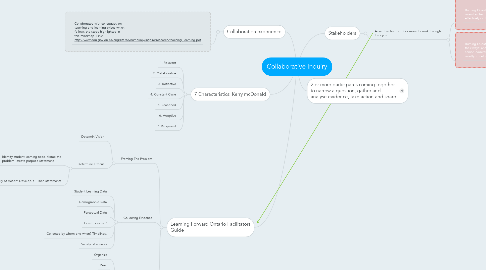
1. 7 Characteristics: Kerry mcDonald
1.1. 1. Relevant
1.2. 2. Collaborative
1.3. 3. Reflective
1.4. 4. Constant Cycle
1.5. 5. Reasoned
1.6. 6. Adaptive
1.7. 7. Reciprocal
2. Learning Forward Ontario Facilitators Guide
2.1. Framing The Problem
2.1.1. Determin Vision
2.1.2. Determine a focus
2.1.2.1. Identify student learning need, frame the problem, create purpose statement
2.1.2.1.1. Burning Question: With many and varied student needs, what takes precedence for the next inquiry?
2.1.2.2. Theory of Action: Develop If...Then statements
2.2. Collecting Evidence
2.2.1. Student Learning Data
2.2.2. Demographic Data
2.2.3. Perceptual Data
2.2.4. How Collected?
2.2.5. Collected by whom and when? Timelines.
2.2.6. Variety of sources
2.3. Analyzing Evidence
2.3.1. Organize
2.3.2. Read
2.3.3. Describe
2.3.4. Classify
2.3.5. Interpret
2.4. Celebrating and Sharing
2.4.1. Report
2.4.2. Recommend
3. Collaboration experience
3.1. Collaborated with colleagues on teaching and learning cylces which follows the steps highlighted in this mindmap. Link: http://www.edu.gov.on.ca/eng/literacynumeracy/inspire/research/teaching_learning.pdf
4. 2 or more participants coming together to narrow a question, gather and analyse evidence, take action and share.
5. Stakeholders
5.1. Assemble team of 2 or more to work through the cycle
5.1.1. Burning Question: How are already overstretched teachers afforded release time to effectively do the process justice?
5.1.2. Burning Question: Some teachers can be 'set in their ways' and happy to 'go it alone'. How do senior leadership get buy-in without being overtly forceful.
